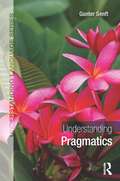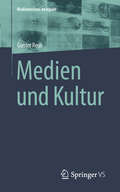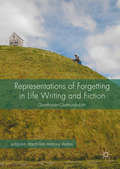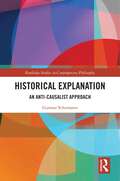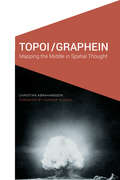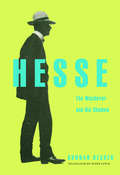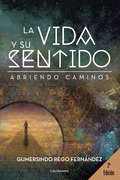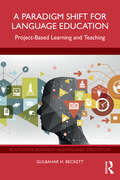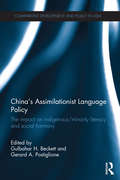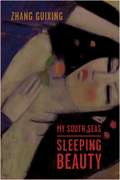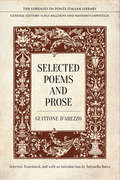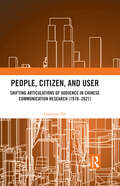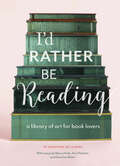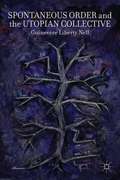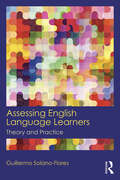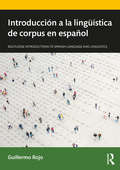- Table View
- List View
Understanding Pragmatics (Understanding Language)
by Gunter SenftUnderstanding Pragmatics takes an interdisciplinary approach to provide an accessible introduction to linguistic pragmatics. This book discusses how the meaning of utterances can only be understood in relation to overall cultural, social and interpersonal contexts, as well as to culture specific conventions and the speech events in which they are embedded. From a cross-linguistic and cross-cultural perspective, this book: debates the core issues of pragmatics such as speech act theory, conversational implicature, deixis, gesture, interaction strategies, ritual communication, phatic communion, linguistic relativity, ethnography of speaking, ethnomethodology, conversation analysis, languages and social classes, and linguistic ideologies incorporates examples from a broad variety of different languages and cultures takes an innovative and transdisciplinary view of the field showing linguistic pragmatics has its predecessor in other disciplines such as philosophy, psychology, ethology, ethnology, sociology and the political sciences. Written by an experienced teacher and researcher, this introductory textbook is essential reading for all students studying pragmatics.
Medien und Kultur (Medienwissen kompakt)
by Gunter ReusMedien bestimmen unseren Alltag in jeder Lebenslage. Viele Menschen empfinden ihre Macht aber als gefährlich für die gesellschaftliche Kultur. Gunter Reus zeigt dagegen, wie sehr ein Gemeinwesen auf der kulturellen Leistung der Massenmedien aufbaut. Der Autor bedient sich dabei eines weiten Kulturbegriffs und zeichnet nach, wie sie Errungenschaften der Menschheit historisch ausgeformt haben. Ohne Medien gäbe es keine einheitliche Sprache und keinen Austausch von Information und Wissen, wie wir ihn kennen. Es gäbe keine Ausbalancierung sozialer Interessen, keine Kontrolle von Macht, keine Orientierung auf das Gemeinwohl, kein Kunstleben. Auch im Internetzeitalter bleiben Massenmedien, bei aller notwendigen Kritik an ihren Schattenseiten, unverzichtbar als Kulturträger. Sie sorgen für die Transparenz politischen Handelns ebenso wie für die (potentielle) Teilhabe aller am Kunstgeschehen. Damit prägen sie die Kultur der Demokratie wie auch die Kultur in der Demokratie entscheidend mit.
Representations of Forgetting in Life Writing and Fiction
by Gunnthorunn GudmundsdottirThis book primarily focuses on the concept of forgetting, with particular emphasis on how we can trace the forgotten in contemporary life writing and memory texts. It consists of two main parts: the first concentrates on life writing in particular and what the author calls "scenes of forgetting"; the second examines both fiction and autobiographies that deal with questions of collective memory/forgetting. The book's principal aim is to map methods and strategies writers employ when writing the forgotten - it argues that forgetting is a constant companion in any memory text and plays a decisive role in the memory work performed in the texts. The main theoretical objective is to examine carefully the connection between collective memory and personal memory, by drawing from two disciplines at once: memory studies and theories on life writing. By considering both areas of research, the conclusions of this study are able to feed into both theoretical perspectives.
Historical Explanation: An Anti-Causalist Approach (Routledge Studies in Contemporary Philosophy)
by Gunnar SchumannThis book is concerned with the appropriate form of explanations in historiography and the social sciences. It combines action theory and philosophy of historiography and develops a theory of teleological explanations of human actions based on late-Wittgensteinian and Ordinary Language Philosophy insights. In philosophy of action, many philosophers favor causal theories of human action. Additionally, in current philosophy of historiography the majority view is that historians should explain historical phenomena by their causes. This book pushes back against these mainstream views by reviving an anti-causal view of explanation of current and past human actions. The author argues that disciplines that deal with human actions require a certain form of explanation, namely a teleological or intentional explanation. This means that past human actions and their results will have to be explained by reasons of agents, not by causes. Therefore, historiography employs a method of explanation which is in stark contrast to the sciences. The author thus proposes a Verstehen (understanding) approach in historiography and the social sciences. Historical Explanation will be of interest to scholars and advanced students working in philosophy of action, philosophy of history, and philosophy of the social sciences.
Topoi/Graphein: Mapping the Middle in Spatial Thought (Cultural Geographies + Rewriting the Earth)
by Christian Abrahamsson Gunnar OlssonIn Topoi/Graphein Christian Abrahamsson maps the paradoxical limit of the in-between to reveal that to be human is to know how to live with the difference between the known and the unknown. Using filmic case studies, including Code Inconnu, Lord of the Flies, and Apocalypse Now, and focusing on key concerns developed in the works of the philosophers Deleuze, Olsson, and Wittgenstein, Abrahamsson starts within the notion of fixed spatiality, in which human thought and action are anchored in the given of identity. He then moves through a social world in which spatiotemporal transformations are neither fixed nor taken for granted. Finally he edges into the pure temporality that lies beyond the maps of fixed points and social relations. Each chapter is organized into two subjects: topoi, or excerpts from the films, and graphein, the author’s interpretation of presented theories to mirror the displacements, transpositions, juxtapositions, fluctuations, and transformations between delimited categories. A landmark work in the study of human geography, Abrahamsson’s book proposes that academic and intellectual attention should focus on the spatialization between meaning and its materialization in everyday life.
Hesse: The Wanderer and His Shadow
by Gunnar DeckerAgainst Nazi dictatorship,the disillusionment of Weimar, and Christian austerity, Hermann Hesse’s stories inspired a nonconformist yearning for universal values to supplant fanaticism in all its guises. He reenters our world through Gunnar Decker’s biography—a champion of spiritual searching in the face of mass culture and the disenchanted life.
La vida y su sentido: Abriendo caminos
by Gumersindo Rego FernándezEl ser humano dando sentido a su vida y humanizando el mundo. Si hay respuestas a las preguntas que el ser humano se formuló sobre el sentido de la vida y si hay solución a los grandes problemas que se le plantean al hombre, incluidos el envejecimiento y la muerte, deben insinuarse en la propia naturaleza, deben haber sido captados por la mente humana, ya sea por observación directa, ya sea por información recibida de otras fuentes, y deben haber sido ya propuestas a la humanidad. <P><P>Por tanto, intentamos identificar las tendencias evolutivas del universo y de la vida, desde la física a la metafísica, pasando por la biología, la psicología y el conocimiento. <P> Las propuestas más fiables deberían coincidir con las tendencias evolutivas por formar parte del mismo sistema. <P>La arquitectura y estructuras impresas en el cerebro humano deben indicar el rumbo a seguir por la evolución y deben ser una buena guía para encontrar y darsentido a nuestra vida.
A Paradigm Shift for Language Education: Project-Based Learning and Teaching (Routledge Research in Language Education)
by Gulbahar H. BeckettThis book investigates the argument for the significance and necessity of project-based learning and teaching (PBLT), as it becomes increasingly important in language education.Drawing on research and professional literature spanning over 100 years, it explores the research foundations and the historical and theoretical antecedents of PBLT, articulating the application of PBLT as a valuable approach for second language education pedagogy and research. Utilizing qualitative classroom research conducted in Canada, it then moves to address key concerns surrounding the difficulties of effectively implementing PBLT with existing curriculum and keeping track of content acquisition, cognitive and social skills development, and language learning.Authoritatively written, and offering fresh insight into how the field can be advanced by engaging second language (L2) students in deeper learning and higher order thinking with 21st-century PBLT contextually, situationally, and multimodally, it makes a valuable pedagogical and research contribution that benefits practitioners and researchers in the field. As such, it will appeal to researchers, faculty, and L2 professionals with interests in L2 education, multimodal teaching and learning, and applied linguistics.
China's Assimilationist Language Policy: The Impact on Indigenous/Minority Literacy and Social Harmony (Comparative Development and Policy in Asia)
by Gerard A. Postiglione Gulbahar H. BeckettChina has huge ethnic minorities – over 40 different groups with a total population of over 100 million. Over time China’s policies towards minority languages have varied, changing from policies which have accommodated minority languages to policies which have encouraged integration. At present integrationist policies predominate, notably in the education system, where instruction in minority languages is being edged out in favour of instruction in Mandarin Chinese. This book assesses the current state of indigenous and minority language policy in China. It considers especially language policy in the education system, including in higher education, and provides detailed case studies of how particular ethnic minorities are being affected by the integrationist, or assimilationist, approach.
English (Second Language) class 2 - GSTB
by Gujrat Rajya Pathypustak Mandalધોરણ 1 અને 2 માં વિદ્યાર્થીઓના માત્ર શ્રવણ અને કથન કૌશલ્યો પર જ ધ્યાન કેન્દ્રિત કરીશું. વાંચન અને લેખન કૌશલ્યો શીખવાની પ્રક્રિયા ધોરણ 3 થી ચાલુ થશે.
English (Second Language) class 3 - GSTB
by Gujrat Rajya Pathypustak Mandalધોરણ - 3 થી વાંચન અને લેખન કૌશલ્યો શીખવવાની પ્રક્રિયા શરૂ કરીએ છીએ. વાંચન અને લેખન કૌશલ્યોનો પ્રારંભ કરાવવા માટે આ પાઠ્યપુસ્તક ઘડાયું છે. જે શબ્દો બોલતાં આવડે છે તે શબ્દોનું હવે વાંચન અને લેખન શીખવાનું છે.પ્રસ્તુત પુસ્તક દ્વારા વિદ્યાર્થીઓને ગમતી પ્રવૃત્તિઓનો સમાવેશ કરીને હસતાં રમતાં અંગ્રેજી આવડે તેવો પ્રયાસ છે.
Lapwing - Supplementary English Reader (Second Language) class 12 - GSTB
by Gujarat State Textbook Board"Lapwing Supplementary Reader English Second Language Std. 12" is a comprehensive book designed to enhance English language proficiency for students at the secondary level. With a focus on second language acquisition, the book presents a diverse range of engaging texts, including stories, essays, poems, and articles, carefully selected to cater to the linguistic and literary needs of learners. Through thought-provoking content and varied exercises, the book aims to improve students' reading comprehension, vocabulary, grammar, and writing skills. It also encourages critical thinking and cultural awareness through exposure to different themes and perspectives. From classic literature to contemporary pieces, "Lapwing Supplementary Reader" offers a rich tapestry of English language and literature, providing students with a solid foundation for effective communication and deeper appreciation of the language.
Black Buck Supplementary English Reader (Second Language) class 10 - GSTB
by Gujarat State School Textbook BoardThe Black Buck Supplementary Reader for Standard 10, published by the Gujarat State School Textbook Board, is an engaging resource designed to enhance English language proficiency for secondary students. Named after the elegant and swift blackbuck, this reader aims to introduce a variety of topics, from scientific discoveries to moral lessons, in an accessible format. It includes 22 diverse reading selections such as stories, poems, and thought-provoking exercises, each accompanied by questions to promote critical thinking. The content is structured to help students expand vocabulary, improve comprehension, and engage with English in a meaningful, enjoyable way. The reader also encourages self-expression and creativity through interactive activities.
Dolphin Supplementary Reader (English Second Language) class 9 - GSTB
by Gujarat State School Textbook BoardThe English supplementary reader for 9th-grade students, with a variety of lessons covering different stories, moral anecdotes, and educational exercises. It is designed to enhance students' English language skills, focusing on reading comprehension, vocabulary building, and critical thinking. The content includes short stories, informative articles about animals like dolphins, and classical tales with moral lessons, such as "The Ugly Duckling" and "The Fun They Had." Each section is accompanied by exercises encouraging self-reflection, creative thinking, and group discussions, helping students develop both linguistic abilities and life skills.
Flamingo Supplementary Reader (English Second Language) class 11 - GSTB
by Gujarat State School Textbook BoardThe "Flamingo Supplementary Reader" for 11th grade English (Second Language), published by the Gujarat State School Textbook Board, provides students with a variety of engaging and diverse reading materials aimed at enhancing their English proficiency. It features a collection of stories, folk tales, poems, and moral lessons designed to promote both language development and critical thinking. The supplementary reader complements the main textbook by encouraging self-learning, creative thinking, and reading for pleasure. Through relatable content and exercises, it helps students develop comprehension, expand their vocabulary, and improve their language skills. The reader also focuses on real-life applications of English and aims to support students in excelling at national and international levels, particularly in competitive exams.
English (Second Language) class 5 - GSTB
by Gujarat State Board of School TextbooksThe provided textbook for Standard 5 English (Second Language) is designed to develop multilingual communication skills in young learners as outlined in the NEP 2020. The book includes activities such as stories, action songs, games, and exercises to make learning engaging and effective. It emphasizes listening and speaking skills initially and gradually incorporates reading and writing. The text aims to teach English in a fun, interactive manner, avoiding traditional translation methods and extensive grammar explanations. Activities are structured to enhance vocabulary through context and real-life application. Additionally, the book supports continuous assessment and encourages the use of local resources and teaching aids to facilitate effective language learning.
My South Seas Sleeping Beauty: A Tale of Memory and Longing (Modern Chinese Literature from Taiwan)
by Guixing ZhangMy South Seas Sleeping Beauty is a captivating coming-of-age tale set in the magical jungles of Borneo. Told through the vivid recollections of a Chinese-Malay youth, the novel recounts the life of Su Qi, a troubled, sensitive son of a wealthy family, and exemplifies the imaginative range of one of Taiwan's most innovative writers. "There were all sorts of stories about how my younger sister died," Su Qi begins, hinting at the power of memory to bend and refract truth. Yet whichever the real story may be, the fact is that the death of Su Qi's sister created an irrevocable rift in Su Qi's family, driving his father into the arms of aboriginal women and his mother into a world of her own invention. In an effort to escape the oppression of home, Su Qi loses himself in the surrounding jungle, full of Communist guerillas and strange tropical fauna. The jungle further blurs the line between fantasy and reality for Su Qi, until he meets Chunxi, the beautiful, frail daughter of his father's best friend. Chunxi is an oasis of kindness and honesty in an otherwise cruel and evasive world, but after a bizarre accident, Chunxi falls into a deep coma, and Su Qui flees to Taiwan. In college Su Qi meets Keyi, a vivacious siren who helps Su Qi forget not only his violent past but also the colorful tales of his youth. When a family member dies, however, Su Qi is pulled back to the jungles of Borneo where he begins to unravel the secrets of his family's past-a story stranger than any fairy tale-and learns that his cherished dream of awakening his beloved Chunxi may be more than just a fantasy. Influenced by the lyricism of William Faulkner and the magical realism of Gabriel Garcia Marquez, My South Seas Sleeping Beauty is a deeply evocative exploration of sexuality and identity and a masterful reworking of Chinese and Western myth. Valerie Jaffee's careful translation retains all the tone and detail of the original work and provides rare access to a new and exciting generation of Chinese writers born in Southeast Asia.
Selected Poems and Prose
by Antonello Borra Guitonne D'ArezzoGuittone d’Arezzo (ca. 1230-1294) was the most important, prolific, and influential poet and prose writer of the thirteenth century. Unfortunately, his work has been overshadowed by his successor; the more learned and gifted Dante Alighieri. The poems and prose included in this volume are emblematic of the two phases of Guittone’s career: he first achieved fame as a secular love poet but following his conversion in the 1260s he became a renowned religious poet. Guittone’s artistic reputation commanded the highest respect. Even Dante’s beloved Guinizzelli and Cavalcanti never enjoyed any such fame in their lifetime. Antonello Borra presents a critical introduction to Guittone’s works with a selection of his poems and letters in facing-page Italian and English translation. While Dante repeatedly condemned Guittone, recent scholarship has re-evaluated his importance and placed his work in the context of his predecessors, the Provençal troubadours and the poets of the Sicilian school. This latest volume in the Lorenzo Da Ponte Italian Library contains the first significant edition of Guittone’s works available in English translation.
People, Citizen, and User: Shifting Articulations of Audience in Chinese Communication Research (1978 – 2021)
by Guiquan XuThe book examines the changing discourses of Chinese audience research in the past four decades, aiming to shed light on the complicated relationships among China’s media, audiences, and society. With the new sociology of knowledge, it adopts Laclau and Mouffe’s discourse theory as a meta-theoretical framework and interprets the concept of audience as a floating signifier. Based on the corpus of Chinese academic journal papers, the author divides the scope of analysis into four phases. In each period, Chinese audience research was related closely to the changing societal and academic contexts and hegemonic struggle as a whole. In addition, it discusses the relation between ‘western’ audience theories and Chinese audience research, as well as the contingency and rigidity of discourses in Chinese audience research. The book contributes to the understanding of Chinese communication research in the changing societal context and will be valuable for scholars of media and communication studies or China studies.
The Orphaned Imagination: Melancholy and Commodity Culture in English Romanticism
by Guinn BattenStudies of the English Romantic poets generally portray them either as transcending the workings of capitalism or as working in complicity with an entrepreneurial economy. In The Orphaned Imagination, Guinn Batten challenges standard accounts of Romantic poetry and argues that Wordsworth, Byron, Blake, Shelley, Keats, and Coleridge--each of whom suffered the loss of a father or father-figure at an early age--possessed an orphan's special insight into the dynamics and aesthetics of commodity culture and its symptomatic melancholia. Building on the theoretical insights of Slavoj Zizek, Judith Butler, Julia Kristeva, and Eve Kosofsky Sedgwick, Batten interweaves the discourses of psychoanalysis, economics, biography, sexuality, melancholy, value, and exchange to question accepted ideas of how Romantic poetry works. She asserts that poetic labor is in fact paradigmatic of the kinds of production--and the kinds of desire--that capitalist culture renders invisible. If symbolic exchange, in cash or in words, requires the surrender of a beloved object, if healthy mourning requires an orphan to "work through" emotional loss through the consolation of art or a love for the living, then the rebellious Romantic poet, Batten contends, possessed unique insight into the alternative authority of a poetic language that renounced a culture of denial. Batten urges that scholars move beyond critical approaches condemning allegedly regressive forms of pleasure, recognizing that they, too, are haunted by melancholic attachments to dead poets as they conduct their work. The Orphaned Imagination will interest anyone concerned with the claims of the English Romantic poets to a distinctive, valuable form of knowledge and those who may wonder about the power of contemporary theory to illuminate a traditional field.
I'd Rather Be Reading: A Library of Art for Book Lovers
by Guinevere de la MareA compendium of delightful essays, poems, photos, quotations, and illustrations for book lovers.For anyone who’d rather be reading than doing just about anything else, this ebook is the ultimate must-have. In this visual ode to all things bookish, readers will get lost in page after page of beautiful contemporary art, photography, and illustrations depicting the pleasures of books. Artwork from the likes of Jane Mount, Lisa Congdon, Julia Rothman, and Sophie Blackall is interwoven with text from essayist Maura Kelly, bestselling author Gretchen Rubin, and award-winning author and independent bookstore owner Ann Patchett. Rounded out with poems, quotations, and aphorisms celebrating the joys of reading, this lovingly curated compendium is a love letter to all things literary, and the perfect thing for bookworms everywhere.
Spontaneous Order and the Utopian Collective
by Guinevere Liberty NellVladimir Lenin, Leon Trotsky, and Nikolai Bukharin were the three leaders of the Russian Revolution who shaped the new society most, both through their theories and their political leadership. All three were motivated by the ideal of building a utopian collective. Once in power, they tirelessly tried to put their vision into practice, but the Soviet system that resulted was nothing like the one they tried to create. In Spontaneous Order and the Utopian Collective, Nell takes her cue from the personal writings and documents of Lenin, Trotsky, and Bukharin to consider them anew from an Austrian theoretical perspective, analyze the divergence between theory and practice using a spontaneous order framework, and identify three interconnected prerequisites necessary for a utopian collectivist society. Nell then asks whether it might be possible to create this utopian collective somehow, and avoid the pitfalls of planning.
Aldous Huxley
by Guinevera A. NanceCriticism and interpretation of Aldous Huxley's works, as well as an overview of his life.
Assessing English Language Learners: Theory and Practice
by Guillermo Solano FloresAssessing English Language Learners explains and illustrates the main ideas underlying assessment as an activity intimately linked to instruction and the basic principles for developing, using, selecting, and adapting assessment instruments and strategies to assess content knowledge in English language learners (ELLs). Sensitive to the professional development needs of both in-service and pre-service mainstream teachers with ELLs in their classrooms and those receiving formal training to teach culturally and linguistically diverse students, the text is designed to engage readers in viewing assessment as a critical part of teaching appreciating that assessments provide teachers with valuable information about their students’ learning and thinking becoming aware of the relationship among language, culture, and testing understanding the reasoning that guides test construction recognizing the limitations of testing practices being confident that assessment is an activity classroom teachers (not only accountability specialists) can perform Highlighting alternative, multidisciplinary approaches that address linguistic and cultural diversity in testing, this text, enhanced by multiple field-tested exercises and examples of different forms of assessment, is ideal for any course covering the theory and practice of ELL assessment.
Introducción a la lingüística de corpus en español
by Guillermo RojoIntroducción a la lingüística de corpus en español es la primera obra concebida desde la óptica del español para investigar los corpus textuales existentes en la actualidad. Destinada a conjugar armónicamente la exposición de cuestiones teóricas y metodológicas, proporciona información detallada sobre las tareas necesarias en el diseño, construcción y explotación de un corpus a partir de numerosos ejemplos de obtención de datos sobre diferentes cuestiones léxicas y gramaticales. Características principales: • Exposición de cuestiones teóricas y metodológicas combinada con el tratamiento de casos prácticos de extracción y análisis de datos procedentes de corpus textuales de español; • Análisis de fenómenos léxicos y gramaticales del español desde diferentes perspectivas y con atención a la variabilidad diacrónica, diatópica y diastrática; • Indicación detallada del modo de obtener los datos necesarios para la investigación en diferentes corpus del español; • Inclusión de un resumen inicial, actividades de investigación en cada capítulo y lecturas complementarias recomendadas; • Presentación de un capítulo final con herramientas informáticas útiles para el análisis de textos no incluidos en corpus textuales; • Recopilación de los principales términos usados en la lingüística de corpus en un glosario bilingüe (español e inglés). Introducción a la lingüística de corpus en español es una obra con un enfoque marcadamente didáctico, y dirigida fundamentalmente a estudiantes avanzados de grado y posgrado, profesores que necesiten hacer uso de corpus en sus clases, investigadores que precisen un conocimiento más profundo de la lingüística de corpus o expertos en otras disciplinas que deseen familiarizarse con una perspectiva técnica de los fenómenos lingüísticos.
